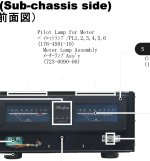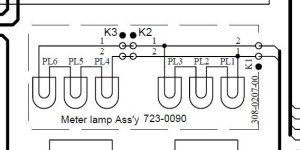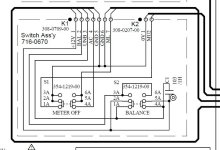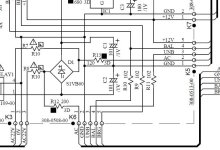Hi all,
I have recently replaced the VU meter lamps on my P5000 but the new ones are rather dim.
I measured the old lamps on a variac set to 12V and they drew 175mA each and so I ordered 12V/150mA replacements but as said, they turned out to be quite a bit darker.
Not sure what I am missing, I do have the service manual (it's available online) but there are no part values shown besides Accuphase part number.
+++
Ok, measured 18.9VAC on the lamp rail, considering the lamps are in series by 3, that would mean they are 6-6.3V parts.
I have recently replaced the VU meter lamps on my P5000 but the new ones are rather dim.
I measured the old lamps on a variac set to 12V and they drew 175mA each and so I ordered 12V/150mA replacements but as said, they turned out to be quite a bit darker.
Not sure what I am missing, I do have the service manual (it's available online) but there are no part values shown besides Accuphase part number.
+++
Ok, measured 18.9VAC on the lamp rail, considering the lamps are in series by 3, that would mean they are 6-6.3V parts.
Attachments
Last edited:
I measured the voltage at the lamp connector inside the amp, 18.9VAC. Strange...
The DCR of the original lamps is around 5-6 ohms, the 12/150mA ones are around 7-8 ohms. Also measured a bunch of brand new 12V/50mA ones and these are about 26-27 ohms.
The DCR of the original lamps is around 5-6 ohms, the 12/150mA ones are around 7-8 ohms. Also measured a bunch of brand new 12V/50mA ones and these are about 26-27 ohms.
Perhaps you weren't aware that incandescent lamp resistance varies very dramatically with applied voltage. So measuring resistance with an ohmmeter won't extrapolate well to observed current at nominal operating voltage--- nor will trying to project resistance at 1/3 nominal voltage.
Bill Hewlett of H-P fame patented using this phenomenon to stabilize amplitude of sine wave oscillators.
Bill Hewlett of H-P fame patented using this phenomenon to stabilize amplitude of sine wave oscillators.
Thank you, apparently the biggest mistake was assuming the lamps were 12V.
I will check the old lamps at 6.3V and measure the current draw.
I will check the old lamps at 6.3V and measure the current draw.
I learned something again thanks to youPerhaps you weren't aware that incandescent lamp resistance varies very dramatically with applied voltage. So measuring resistance with an ohmmeter won't extrapolate well to observed current at nominal operating voltage--- nor will trying to project resistance at 1/3 nominal voltage.
Bill Hewlett of H-P fame patented using this phenomenon to stabilize amplitude of sine wave oscillators.

Ok so I measured the original lamp:
6VAC 116mA
8VAC 138mA
12VAC 175mA
Lamps I had
12V 50mA (bulb from a different shop)
6VAC 28mA (34mA)
8VAC 34mA (40mA)
12VAC 43mA (51mA)
12V 150mA lamp:
6VAC 96mA
8VAC 113mA
12VAC 144mA
6VAC 116mA
8VAC 138mA
12VAC 175mA
Lamps I had
12V 50mA (bulb from a different shop)
6VAC 28mA (34mA)
8VAC 34mA (40mA)
12VAC 43mA (51mA)
12V 150mA lamp:
6VAC 96mA
8VAC 113mA
12VAC 144mA
I surmise there are no true numbers printed on the base of the lamp? What type of base does the lamp use? eg. screw, bayonet, wire leads, etc?
Nope, nothing. They are axial lamps with wire leads.
The schematic also only mentions Accuphase's own P/N. I will order few more different types and compare them by light output to the originals.
The schematic also only mentions Accuphase's own P/N. I will order few more different types and compare them by light output to the originals.
According to the service manual (from Hifiengine) these lamps are axial bulbs soldered to a board.
There are two bulb blocks (3 bulbs in sequence) in parallel (one block per meter) fed from AC 22V via 120R resistor.
Some photos of the particular amp would be of help.
There are two bulb blocks (3 bulbs in sequence) in parallel (one block per meter) fed from AC 22V via 120R resistor.
Some photos of the particular amp would be of help.
Attachments
- Home
- Amplifiers
- Solid State
- Accuphase 5000 lamp value




